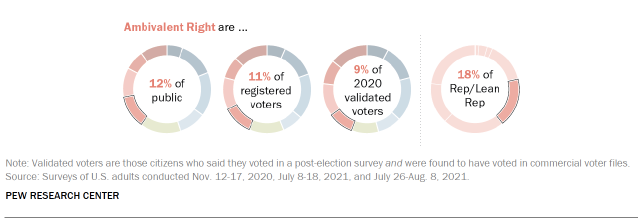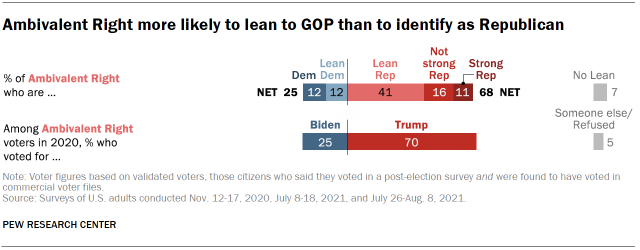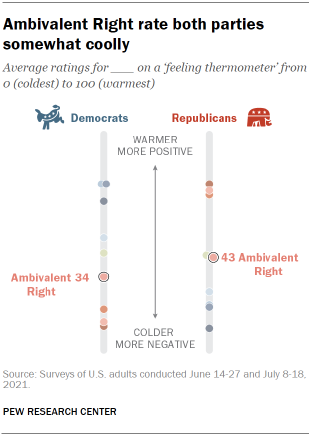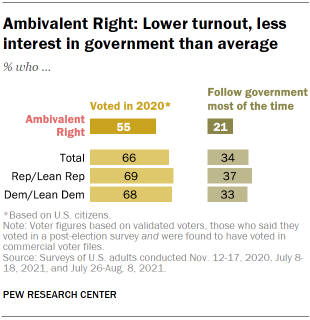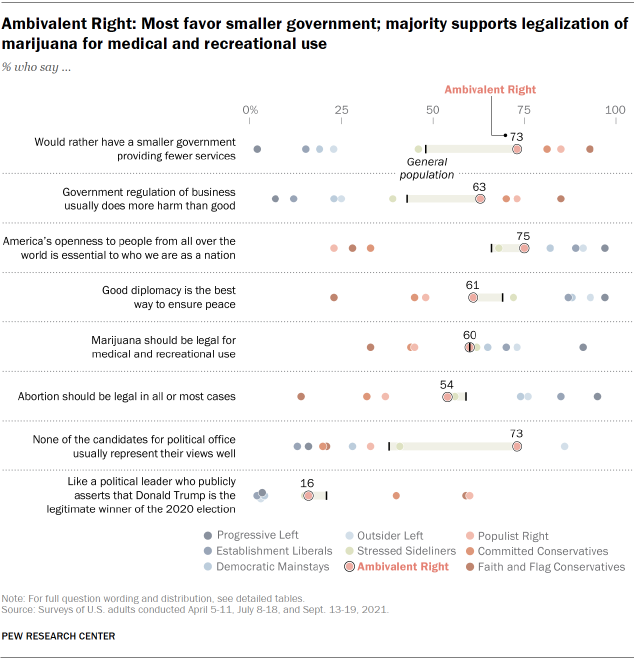Young and politically cross-pressured: Conservative on economics and issues of race and gender, less so on immigration, social issues
On issues ranging from the size of the federal government to views about business, gender and race, Ambivalent Right hold many views that are largely consistent with core conservative values. Yet they also hold more moderate stances on several social issues and differ from some other segments of the GOP coalition in taking a more internationalist view of foreign policy and a less restrictive position on immigration.
Ambivalent Right are a GOP-leaning group as a whole – 68% identify as or lean Republican – and they make up a substantial share of all Republicans and GOP leaners (18%). But this group also includes a significant number of Democrats: A quarter of Ambivalent Right either identify with or lean toward the Democratic Party, and a similar share (25%) voted for Joe Biden in the 2020 presidential election.
With 63% of Ambivalent Right adults under the age of 50, they are substantially younger than other Republican-oriented groups. About two-thirds (65%) are White, 17% are Hispanic, 8% are Black and 5% are Asian, making this group more racially and ethnically diverse than other GOP coalition groups.
Ambivalent Right differ from other GOP-aligned groups with their support for legal abortion and less negative views of the impact of same-sex marriage. They also are distinct from other Republican-oriented groups in their views of Donald Trump. Whereas large majorities of each of the other Republican-oriented groups say they feel warmly toward Trump, Ambivalent Right are somewhat more likely to say they feel coldly toward the former president (46%) than warmly (34%). And most (63%) would not like to see Trump continue to be a major national political figure for many years to come.
Ambivalent Right have also largely rejected the unsubstantiated claim from Trump and others that Trump was the legitimate winner of the 2020 presidential election. Roughly six-in-ten say that Biden definitely or probably received the most votes cast by eligible voters in enough states to win the 2020 election – more than double the share of the Ambivalent Right who voted for Biden, and far higher than the shares in other Republican-aligned groups.
Political affiliation, voting and engagement
About two-thirds of Ambivalent Right (68%) are Republicans or Republican leaners, with a larger share saying they lean toward the Republican Party (41%) than identifying as strong (11%) or not so strong (16%) Republicans. A quarter identify with or lean toward the Democratic Party, and an additional 7% say they do not lean toward either party.
The shares of 2020 voters who voted for Trump and Biden are nearly identical to the shares who identify with or lean toward each party: 70% voted for Trump and 25% for Biden.
Ambivalent Right do not feel very warmly toward either Republicans or Democrats. On a “feeling thermometer” ranging from 0-100, where 100 represents the warmest feelings and 0 represents the coldest feelings, Ambivalent Right give Republicans an average rating of 43. Ambivalent Right are cooler toward Democrats, with an average rating of 34. While some of their coolness toward the GOP reflects that 25% of this group are Democrats and Democratic leaners, even Ambivalent Right who identify with or lean to the GOP give Republicans an average feeling thermometer rating of 49, similar to ratings among the group as a whole; the average rating of Democrats (30) is also similar.
Ambivalent Right are less politically engaged than groups with stronger partisan attachments. About half of eligible Ambivalent Right (55%) voted in the 2020 election, 11 percentage points lower than the share of all adult citizens who voted. Ambivalent Right are also less likely than most other groups to say they follow what’s going on in government and politics most of the time.
Ambivalent Right’s distaste for Trump relative to other Republican-oriented groups does not mean that they are particularly warm toward Biden. Six-in-ten say they feel coldly toward Biden, and just two-in-ten approved of his job performance as president as of mid-September.
Ambivalent Right: Key political attitudes and beliefs
On core issues related to the size and role of government, Ambivalent Right hold views that are traditionally associated with the GOP: Most (63%) say that government regulation of business usually does more harm than good, and nearly three-quarters (73%) prefer a smaller government providing fewer services to a bigger government providing more services.
But they diverge from several other Republican-oriented groups on several social issues, immigration and, in some cases, foreign policy.
Just over half (54%) say abortion should be legal in all or most cases, a view held by far smaller shares of those in other GOP groups. And six-in-ten Ambivalent Right say that marijuana should be legal for both recreational and medical use by adults – identical to the share of the overall public saying this, but a view not held by most of those in other GOP-oriented groups. Ambivalent Right also are as likely to say that same-sex marriage being legal is good for society (28%) as to say that it is bad for society (29%); 43% say it is neither good nor bad. In each of the other Republican-oriented groups, more say legal same-sex marriage is bad for society than say it is good.
Three-quarters say that America’s openness to people from all over the world is “essential to who we are as a nation,” compared with no more than a third of those in other Republican-oriented groups. They are also substantially more likely than those in other GOP groups to say that good diplomacy, rather than military strength, is the best way to ensure peace.
Ambivalent Right are about evenly divided over whether the Republican Party represents them well
Ambivalent Right don’t feel entirely at home in either party. While they lean toward the GOP on many issues, they tilt more moderate to liberal on some others, and their ambivalence is expressed in their assessments of the Republican Party itself.
Half of Ambivalent Right say that the Republican Party represents them either very (4%) or somewhat (46%) well, while a quarter say that the Democratic Party represents them well. Even taking into account the partisan composition of this group, Ambivalent Right who identify as or lean Republican are substantially less likely than Republicans in other GOP-oriented groups to say the party represents them well.
Ambivalent Right: Who they are
Ambivalent Right are younger and more racially and ethnically diverse than other Republican-oriented groups. They are also somewhat less religiously affiliated: 27% are religiously unaffiliated, compared with 20% of Populist Right, 18% of Committed Conservatives and just 6% of Faith and Flag Conservatives.
They are similar to the general population on both household income and education: 28% live in lower-income households (compared with 31% of all U.S. adults), 48% live in middle-income households (vs. 47% of all adults) and 19% live in upper-income households (vs. 17% of all adults). About a third (35%) have a college degree, roughly the same share as among the adult population overall (32%).
Ambivalent Right are less likely than other Republican-oriented groups to turn to Fox News for their political news. Half report getting news from Fox News over the course of a week, compared with at least six-in-ten or more in each of the other Republican-oriented groups.


